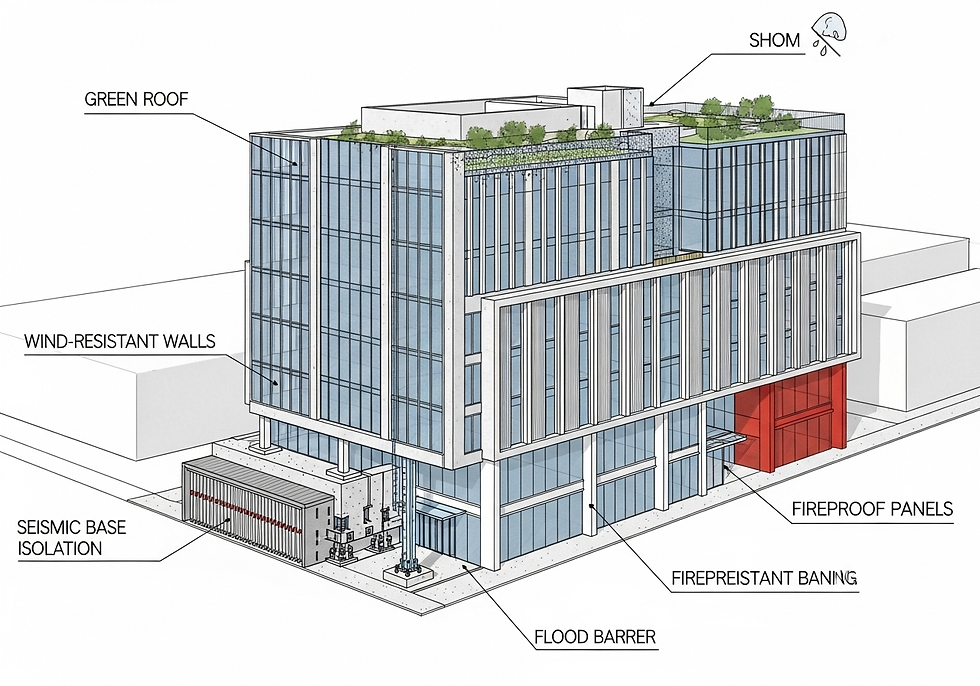"Your 'Disaster-Proof' House Will Fail. Here’s Why." resilient architecture
- Dennis Asis

- Sep 22
- 4 min read

In a world increasingly impacted by climate change, natural disasters, and rapid urbanization, the term "disaster-proof architecture" has become a topic of heated debate. While it sounds appealing to imagine buildings that can stand up to any catastrophe, the reality is much more complex. Can we really construct structures that resist every calamity? Or are we simply dreaming of a future grounded in unrealistic expectations? Let’s analyze the limitations of current architectural practices and advocate for innovative designs that prioritize resilience and adaptability.

The Illusion of Disaster-Proof Architecture
When we talk about "disaster-proof architecture," we imply an unrealistic promise of complete safety. While architects and engineers have developed buildings that can withstand earthquakes, floods, and hurricanes, no structure is entirely immune to all types of disasters.
Natural disasters remain unpredictable, with impacts varying greatly based on many factors, including geography, climate, and human actions. Instead of chasing an impossible standard, we should aim for buildings that are adaptable, able to evolve in response to changing conditions.

Learning from the Past: Architectural Failures
History offers numerous examples of architectural failures that resulted in devastating consequences. For instance is Hurricane Katrina, which devastated several countries reminding us that many structures were built without adequate consideration for flood risks.
These failures are often rooted in outdated designs and a lack of foresight. Many architects continue to rely on models that were never intended to accommodate modern challenges. By analyzing these historical failures, we can extract crucial lessons to inform future architectural endeavors.

Embracing resilient architecture Over Perfection
Instead of aspiring for disaster-proof buildings, architects should emphasize resilience. Resilient architecture focuses on designing structures that can absorb shocks, respond to changing conditions efficiently, and recover swiftly from disasters.
Furthermore, utilizing flexible materials and modular designs can provide quicker repairs and adaptations after adverse events.

The Role of Technology in Future Architecture
Advancements in technology are steering us toward innovative architectural solutions that enhance resilience. Smart building technologies can monitor environmental conditions, adapting systems in real-time to minimize risks. For instance, buildings equipped with sensors can detect structural weaknesses early, leading to prompt repairs.
Additionally, innovations like 3D printing and prefabrication allow for rapid construction and customization. An example of this is the use of 3D-printed homes in flood-prone areas, providing quick, affordable housing solutions. By embracing technology, we can design functional buildings that adapt to a changing world.

Community-Centric Design: A Fresh Approach
An essential aspect of rethinking resilient architecture is community-centric design. Buildings should not only serve their occupants; they should enhance the surrounding community's resilience.
This means considering accessibility, social cohesion, and environmental impact in the design process. A notable example is the rebuilding of neighborhoods in post-disaster areas, where architects collaborate with locals to create spaces that foster community resilience. Understanding community needs leads to designs that are not only functional but also enrich the lives of residents.

Sustainable Practices: Building for Tomorrow
Sustainability is a fundamental element of future architecture. As we confront the realities of climate change, it is vital that we design buildings that reduce their environmental footprint and promote ecological balance.
Incorporating renewable energy sources like solar panels, using sustainable materials, and implementing efficient waste management systems are critical steps architects can take. Such initiatives not only prepare us for disasters but also actively combat their long-term impacts.

The Importance of Education and Collaboration
To genuinely reshape future architecture, we must emphasize education and collaboration within the industry. Architects, engineers, urban planners, and policymakers need to unite to share knowledge and devise innovative solutions.
Fostering a culture of collaboration can break down barriers, encouraging interdisciplinary approaches to design. This teamwork helps us create resilient and adaptable structures that can better withstand the inevitable challenges that lie ahead.
A Future of Resilient Design
The idea of disaster-proof architecture may be more fantasy than reality, but it prompts vital discussions about the future of our built environment. As we face growing challenges posed by climate change and urbanization, we must shift our focus from unattainable ideals to practical, resilient solutions.

By championing adaptability, sustainability, and community-focused design, we can develop buildings that not only endure disasters but also enrich the lives of their occupants. The future of architecture is not about seeking perfection; it's about reimagining our design philosophy to ensure we are prepared for whatever challenges await us.
As we progress toward a more resilient future, every architect, engineer, and community member plays a vital role. Let's collectively strive to create a world that is not only ready for disasters but flourishes even in the face of adversity.
Head over to our Resource Section for more insights and useful references.





Comments